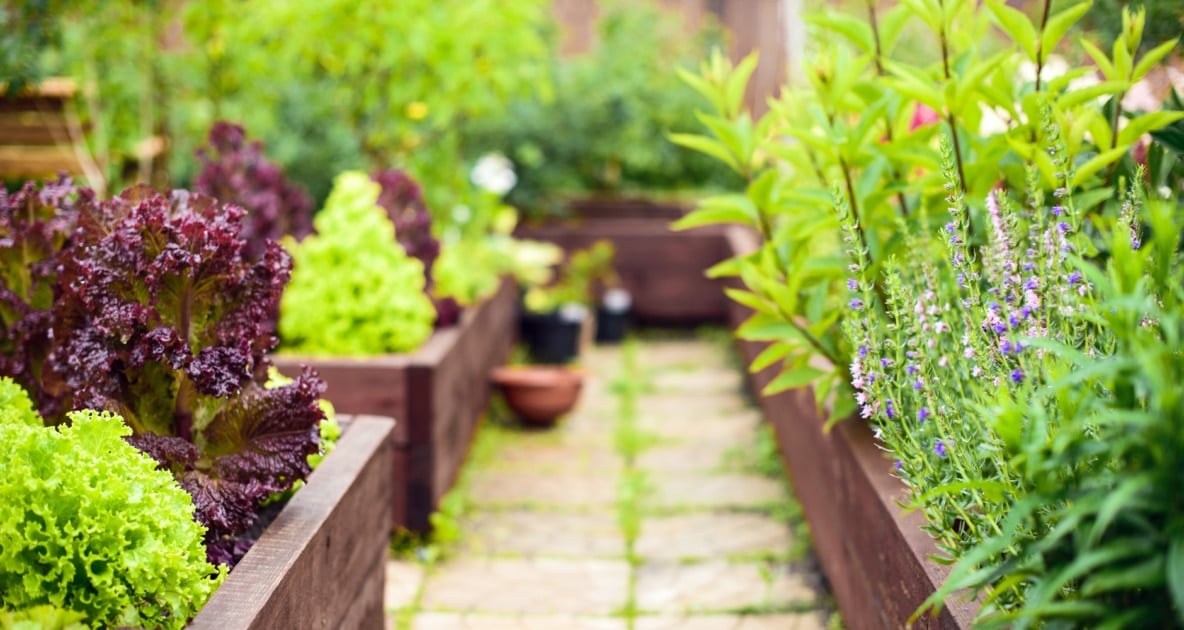How to Build A Raised Bed Garden
Growing your veggies in raised beds offers many benefits to the average backyard gardener. Learn how to build your own.

Growing your veggies in raised beds offers many benefits to the average backyard gardener. One of the most common refrains among gardeners every spring is that they can’t wait to get started. Raised beds offer the opportunity to do just that. Because raised beds are built above the ground, the soil in the bed is warmer than the soil in the ground, meaning you can get gardening earlier by growing in them. By getting started earlier, you can harvest food earlier. You can also harvest longer into the end of the season, extending the length of your growing season.
Another great benefit to raised beds is that you can customize the soil that you grow in. Once you build your frame for the bed, you will be able to add mulch, compost, topsoil, manure, and anything else that will help your garden grow. You can customize your growing medium to best suit your needs. You will also maintain better soil drainage by growing this way.
Building your soil from the bottom up means you will not have to till out rocks, roots, and other matter that inhibits healthy plant growth. You will also not be trampling on your garden, which inhibits root growth and drainage.
Raised beds are also space savers. You can grow your plants closer together for higher yields. You can also companion plant. Most plants grow better when they are planted with other, specific plants. You can perform some very easy research on the Internet or in organic gardening books to learn which plants grow well together.
The basic construction of a raised bed is simple. Decide the size you want, based on the area you have to work with and the amount of gardening you want to do. Remember not to overwhelm yourself with beds that are so big you could never find the time to take care of them. You also don’t want them so small you won’t have enough produce to satisfy your needs.
You can choose to buy pre-fab kits for your raised beds. It will make building them a little easier, but they can be very expensive. Besides, part of growing your own food is the enjoyment of doing it yourself. Everyone should learn to be as self sufficient as possible, especially during these tough economic times.
Use 2×6 or 2×8 lumber for the frame. Cedar lumber is the best choice, because it will outlast any other wood for this application. Some people use pressure treated lumber, as it lasts for years and years in the harsh weather, but doing so is not recommended for any project that has anything to do with fruits, veggies, or livestock. Though pressure treated lumber is much safer today than it was years ago, it is still chemically treated and can leach chemicals into your produce.
You can make your beds as long as you like, but it’s best not to make them more than four feet wide. Weeding, planting and general maintenance will be easier if your width isn’t too large, and your back, muscles and joints will all thank you for it. Cut the pieces of lumber to your desired size. Pre-drill your holes where you will connect them, then screw them all together. Make sure when constructing your beds that they are all level and square.
Now lay them out in the area you will use them to make sure they are level on the ground. Remove any sod, or rocks that keep it from being level. You might have to add material in areas that are lower than other areas. This part of the process is important, because you do not want any water run off in your raised bed, which will inhibit growth.
Now add your growing medium to the level you like and start planting. Six inches of soil is the ideal depth for most vegetables. If you are growing root crops, you’ll need ten inches of soil. Just add another level of lumber over the first layer, or use 2 x 10 or 2 x 12 boards. Once you have your plants in, water well. You will now be on your way to easy maintenance veggie gardening!

Shawn Weeks
Shawn is a lifelong New Englander. He lives in Canton, Conn., with his wife Tami, mother, sister, and her three children. He and his wife have two grown children and two grandchildren. Shawn is an avid hunter, fisherman, and gardener. He is also a writer, a nuisance wildlife professional, small scale farmer, and scout leader. You can email him at [email protected].






To keep slugs and snails from eating your plants save your eggshells, bake them for five minutes crumble them up and sprinkle them around your plants. Not only does it keep the slugs and snails away, it adds calcium to your garden. When you set out your tomato plants mix two cups bone meal, two cups blood meal and one cup eppson salts together, place two tablespoons of mixture in the bottom of the hole before you put in the plants, cover it lightly with soil and then set in your plants, it gives the plants a boost and wonderful taste, you can also add another spoon full around the roots later in the season for another boost. I’ve used it for years and always have wonderful tomatoes! I raised them in five gallon buckets on the patio of my apartment and gave tomatoes to my neighbors and the repair man. I put holes in the buckets about 1/2 ” from the bottom for drainage!
These “raised bed” gardens started becoming popular about 10 years ago. They are a joke, and offer NO benefits of gardening in the ground. You still have all the same problems: insects, weather, varmints, etc.
I think it depends on where you live and what you plan on using it for. I’m planning to install a raised garden bed just for vegetables. I think it comes in handy for that especially in areas with poor soil. We have of clay with shale mixed so a raised garden with fertile soil would work well. And we have a huge deer problem – nearly all my neighbors have raised beds that are fenced in.
exactly what I deal with here in my neighborhood. I have my raised garden bed fenced in because of deer but also the soil her is rock/brick backfill so not worth my time to try to garden in.
I beg to differ, raised bed gardens are in the ground. You have the same benifits as regular gardening only using a smaller space!
If you, like I, live where the soil isn’t soil but rock/brick because your neighborhood was created using this stuff as backfill with barely 3 inches of soil over top of it, you are like myself would be grateful for the person that invented raised beds. Without my raised beds, I would not have a garden at all as the expense of adding enough soil that storms wouldn’t send down the hillside would be astronomical.
My back would disagree
I keep a thick layer of straw on top of my raised beds & that seems to have stopped the cats from digging in the beds, plus it’s great for the soil. Squirrels kept digging up my garlic so I laid chicken wire over the top of the bed.The garlic grows up through the holes & is easy to lift off at harvest & the squirrels stay out.
thank you for hte straw tip. I have feral cats everywhere and in my flower bed I have had to cover with wire to keep them out until the plants are established. ugh!
Squirrels are bad for your birdfeeders and gardens. When I put out bird seed I add chili powder to the feeder along with the seed. Birds can’t smell it but the squirrels can and the won’t go near the feeder.
we feed the birds on top of our small shed to keep the feral cats from killing the birds and the squirrels out of the feed. They don’t have access thank goodness.
I need help in ways to keep squirrel’s out of my bird feeders. I have seen those feeders that swing the squirrel off, but they cost is very high. When I was younger, with my Dad, we went squirrel hunting, but in my yarn since I do have people living around me. Need all the help I can get. Thank you in advance for your help.
add chili powder to your feed. Birds eat it but squirrels stay clear
Use newspaper as your first layer.
I’ve used newspaper to kill existing grass under my above ground garden. I just placed the newspaper – a few pages thick directly on the ground, then I added a layer of landscaping mesh, then added my soil mixture (compost, vermiculite and peat moss). I’ve read Square Foot Gardening by Mel Batholomew to get the correct mixture.
The BEST way I know of killing the grass (and weeds) is to burn a brush pile (or firewood) on top of it. Once it’s burned down to ashes/cinders, you can till that into the soil, thus adding potash to your amendments! =)
I killed mine where my raised bed is sitting by placing a tarp over it through the winter, then I added a thick layer of cardboard then my soil. No problems so far and from what I read, worms will be attracted to the cardboard thus bringing worms to the garden bed. win, win in my book.
Just a FYI, after moving to Florida and our soil is almost 90% sand, we decided to make raised gardens. We decided to try something different as the dollars were scarce from the move and buying a new house. We decided to make our raised garden with sand bags. We purchased around 300 poly bags at around 30 cents a bag, and the sand is free. We stacked them 2 bags high, 4’x28′ and plan to have 3 of this size and then a smaller strawberry bed and then decided to cover the white bag with ground cloth to preserve the bag from sun rot. It is very solid and completely weed free, we have placed pine straw around the perimeter to keep outside weeds at bay. We just planted a few things to see how our soil is and we now have a nice crop of beans and other things popping out even in this hot summer.
I built our above ground garden with large rustic brick border, it is about 15″ high and about 15 ft long. I put down a earth layer cloth to keep the weeds out and dug into the ground to take off the layer of grass off as well. I filled the garden with approx 750 lbs of various dirt consisting of Maneure, Scotts organic garden soil, and basic top soil. The garden has flourished with greens! Cilantro, Bezel, parsley, tomatoes, red onion, zuccini, string beans, lettuce, cucumber, and egg plant!